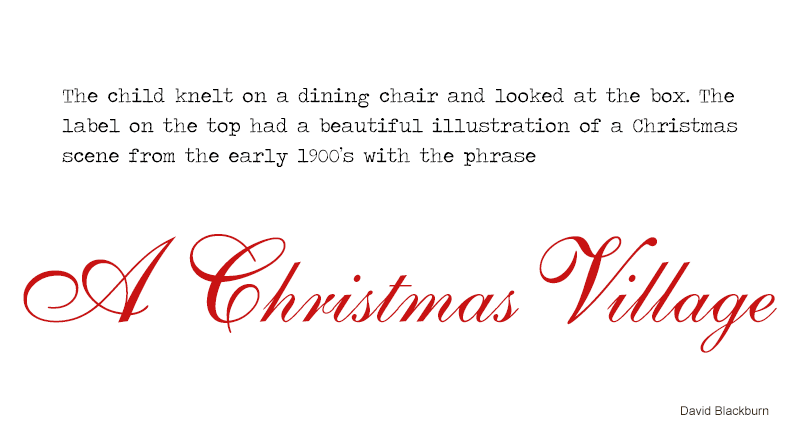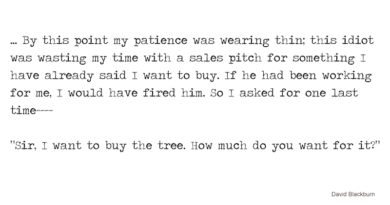A Christmas Village
By David Blackburn
The little girl looked out the living room window as the raindrops streaked the glass, much like the tears that flowed from her sad and beautiful eyes. She turned to the old woman who sat next to her and asked, “Grandma, when will it be Christmas? Will it be Christmas soon?”
The little girl spent a lot of time at her grandmother’s house. Her own home was not a happy place for her and she found both love and safety in the warmth of her grandmother’s smile. Christmas was a very special time for the little girl. It was the only time of the year where she could put aside her sadness and fears as she escaped into what her heart said Christmas was supposed to be—kindness and joy and happiness for everyone. She asked again, “When will it be Christmas, Grandma?”
The old woman’s heart was breaking as she saw the sadness and isolation in her beloved granddaughter. A trace of a tear began to cloud her own eye as she said, “Well, honey, Christmas is still a few weeks away, but we can start Christmas right now if you want to. I have something to show you.” She took the little girl by the hand and led her into the dining room, where a large cardboard box rested on the table. “This is for you, precious. This is your very own personal Christmas.”
The child knelt on a dining chair and looked at the box. The label on the top had a beautiful illustration of a Christmas scene from the early 1900’s with the phrase “A Christmas Village” written in seasonal script. Her eyes widened with excitement as she turned to her Grandmother and asked, “What is it?”
“Let’s open it and see,” said her Grandmother. She helped the little girl remove the top of the box and encouraged her to start taking out each item and placing it on the dining table. Soon the table was covered with miniature buildings and tiny people. Every figure had some representation of the Christmas season—people carrying packages wrapped in red and green, a horse drawn sleigh gliding over the snow, small figures of carolers singing on the village green—and the little girl’s eyes grew wider and wider as she immersed herself into the vision of Christmas that she so desperately wanted to experience; a place where sadness did not exist. Her Grandmother brought out a large piece of fluffy cotton that covered the top of the dining table like freshly fallen snow and the two of them began to assemble the Christmas Village. Each building was exquisite in its detail; the barbershop featured a man in the chair getting his hair cut by an old fashioned barber with scissors in one hand and a comb in the other. The general store had a barrel of apples sitting on the wooden sidewalk in front of the window, the post office had a line of people waiting to mail Christmas packages, the city hall was trimmed in Christmas lights and had wreaths on the doors, a group of boys threw snowballs in the park, and everywhere the people exuded the emotions that encompass Christmas. The little girl was overjoyed and her Grandmother’s heart was filled with happiness for her.
So every day after school the little girl would run to her Grandmother’s house and kneel on the chair at the dining table. She would picture herself in that tiny village, sharing the Christmas of her imagination with all the people who lived there and joining them in the warmth and wonder of Christmas as it used to be. She would stay at the table until suppertime and she and her Grandmother would eat their dinner on TV trays in the living room. After finishing her meal she would return to the dining table and the Christmas Village and her Grandmother could hear her talking to the tiny residents, giving rise to conversations about gifts and parties and Christmas songs. She would stay entirely focused on the world that existed on the dining table until her bedtime; her Grandmother would walk her home and wait patiently for the next day, when the little girl would burst through the door after school and again run to the dining table where she would greet each and every tiny figure with the names she had given them. In her mind’s eye she could see and hear the people talking, laughing, and singing. She was happier than she had been in a long, long time.
Each year she looked forward to Christmas and to setting up the Christmas Village on her Grandmothers’ dining table. Everyone saw how much enjoyment and happiness she got from the Village and every year her aunts and uncles and cousins would give her a new piece for the miniature community. Once her Uncle Tom added an old milk wagon pulled by two sturdy horses. Next came an old turn of the century motor car driven by a jolly man bundled up in a fur coat. More and more tiny figures began to line the wooden sidewalks and the beauty of Christmas grew and grew. The little girl’s delight knew no bounds. There were times when she was still sad and unhappy, but the ability to escape into the Christmas Village offered her an opportunity for happiness that she had not known previously; the Village and its inhabitants—and the love of her Grandmother—saved her from a childhood of melancholy and despair.
As time passed and the little girl grew older, she did not play with the Christmas Village as much. In her teen years the Christmas Village began to remain in its box in the attic and no longer graced her Grandmother’s dining table each year. The little girl became an adult and soon had a husband and children of her own. She had learned how to be happy. One day her own daughter brought a friend home from school during the holidays. This young child had very sad eyes and reminded her of her own youth and sadness. She sat next to the young girl and talked with her; she found that this child also had an unhappy home life and was searching for something to hold on to—she was searching for hope and was not finding it anywhere. The woman saw in her daughter’s friend a sense of loneliness that touched her heart. She saw herself in those young eyes and recognized her own tears from so long ago.
“How do you like Christmas,” she asked the sad child.
“I love Christmas time, but we don’t have a real Christmas at our house,” replied the girl. “We have a little tree sometimes….”
“Well, maybe we can do something about that. You wait right here for a minute.”
The woman went up the stairs into the attic and came down with a large cardboard box. The box was stuffed with so many items that the lid would no longer close properly; she placed it on the dining table and asked the child to read the label on the top. The label, old and faded, revealed the contents: the Christmas Village. She opened the box and began to place the tiny figures and miniature buildings on the table; as she did so the eyes of the little girl began to grow wider and wider and her tears stopped flowing. Soon the three of them—the woman, her own daughter, and the sad youngster—had built the tiny community and it sprang to life as it had so many years before. They imagined the conversations of the townspeople, the songs of the carolers, the sound of the horses’ hooves as they pulled the sleigh on the frozen snow, and the bells ringing in the church tower as the townspeople gathered to celebrate the true meaning of the season. The little girl became enthralled by the Christmas Village and her sadness began to fade away. The tears in her eyes were replaced by a sparkle and her smile beamed like the sun on a cloudless day.
They left the tiny figures and buildings on the dining table for the remainder of the holiday season and the two children would play with them every day after school. And the Christmas Village saved another child by replacing sadness with joy.


